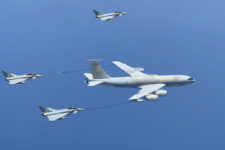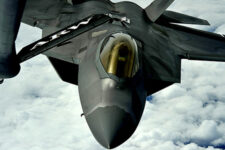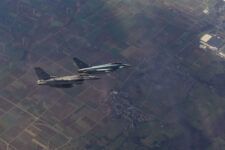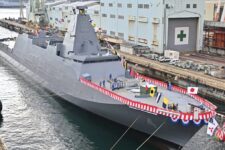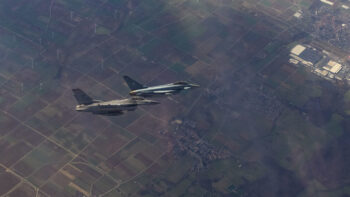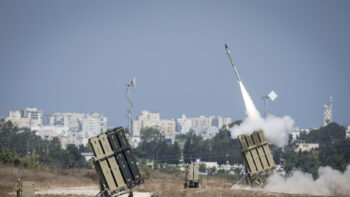In partnership with the U.S. Air Force, Northrop Grumman is evolving the software development process, delivering speed and efficiency in development, and ensuring rapid upgradeability of platforms like the B-21 Raider once fielded. In this Q&A, we discuss the B-21 program’s status with Steve Sullivan, vice president and general manager, Strike Division.
Breaking Defense: Tell us about DevStar and how it relates to the B-21.
Sullivan: DevStar is a software-development philosophy championed by the U.S. Air Force to field effective warfighting capabilities by eliminating process bottlenecks. This keeps our delivered systems and the warfighters that use them ahead of our adversaries. The DevStar approach centers on four characteristics for rapid software development.
First is speed for tight cycle times that enable user feedback and reduce integration risk. Second is quality so that the capability produced is what the warfighter needs while minimizing delivered defects. Third is focus, which delivers a smaller set of working capabilities vs. a large set of partial capabilities. And lastly there’s collaboration for synchronized efforts among the government, prime contractors and suppliers.
DevStar is a derivative of the end-to-end software pipeline known as DevOps where small pieces of usable software are constantly developed and then quickly improved with feedback from users. In DevStar, the asterisk or “star” is used as a wildcard symbol to identify parts of the software delivery pipeline that are required for delivering software to a platform. In the case of the B-21, which will execute both conventional and nuclear missions, this approach ensures mission critical functions like security, airworthiness and weapons certification are addressed.
For example, each software release for the B-21 must have ‘first-touch quality’ built in from the beginning. This requires synchronization of government, prime contractor, and suppliers, as well as the key quality stakeholders within each organization such as airworthiness, safety, security and, of course, the end user.
Northrop Grumman is implementing this approach across several other efforts, to include the Ground Based Strategic Deterrent to replace the LGM-30 Minuteman III intercontinental ballistic missile and the Joint All-Domain Command and Control initiatives to link sensors with shooters from all services and across coalition partners.
Breaking Defense: How are the Air Force’s DevStar initiatives affecting software development on the B-21 Raider?
Sullivan: Virtually all weapon systems developed over the past three decades have required vast amounts of software to enable the delivered capability. These weapon systems require near constant software updates to keep up with hardware changes and emerging threats on the battlefield. The B-21 is no different.
Working in partnership with the U.S. Air Force, the DevStar software approach pushed our early development into afterburner to deliver code at a blistering pace. Our continuous certification pipeline streamlines embedded flight, safety, mission, and even training software requirements to rapidly deliver end-to-end integrated capabilities. With the emerging dynamic threat environment, this rapid capability delivery is not a luxury. It is an operational imperative.
This has been a journey we’ve taken with the U.S. Air Force since the very beginning of the program. Every day we pursue continuous process improvement initiatives to drive us closer to the imperative of continuous, rapid software delivery to the warfighter. I’m impressed with the progress our team has made to date. I look forward to working closely with the Air Force to even further integrate this software development process into the B-21 ecosystem.
Breaking Defense: Rapid software delivery sounds incredibly ambitious. How has Northrop Grumman prepared for the task?
Sullivan: Software development and rapid are not terms traditionally used in the same sentence with major weapons systems. We invested early in development infrastructure—including the 270,000 sq. ft. dedicated lab at our Manned Aircraft Design Center of Excellence in Melbourne, FL. We also cultivated a highly skilled workforce with expertise in DevStar, containerization through Kubernetes, open systems architectures, and other key weapons system functions. Most important of all, we focus on building our software incrementally to deliver minimally viable products targeting frequent, early warfighter capability demonstrations. This approach to software development enables the delivery of quality software for the B-21 Raider – a key differentiating characteristic of the bomber.
Our investments have paid off. Last year, the former Assistant Secretary of the Air Force for Acquisition, Technology and Logistics praised our independent research and development demonstration where we ran cloud-native open mission-systems software with Kubernetes on flight-ready hardware. In addition, we recently completed a major mission system suite demonstration on the B-21 where we flew real hardware and software in an operationally representative environment. These early test events serve to mature our hardware and software suite, which will drive down risk as we enter our flight-test campaign.
We couldn’t have done this if we didn’t have the experience, lab, and testing environments, and most importantly, talented people in our various development locations. Last year’s demo was a big accomplishment for us. Early warfighter feedback from that demo was very positive, setting the stage for future successes in software deliveries on this program.
Breaking Defense: Are there other methodologies or approaches you are applying to software development?
Sullivan: As mentioned, we are leveraging agile model-based systems engineering. Agile development fits nicely within DevStar, as the goal of agile is small, functionally based software releases that are incrementally demonstrated and eventually combined to become larger system software releases. Agile also enables us to unite and align cross-functional stakeholders throughout the definition, development, integration, test, and delivery of the B-21’s capabilities. This approach helps our team make educated early-to-need decisions on resource allocation for feature development, technical debt reduction, or defect resolution.
Our engineers iteratively prioritize and scope the B-21’s capabilities based on their criticality to near-term program milestones versus the traditional approach to fix software feature sets years before release. This helps us continuously update our priorities to deliver software that meets the evolving warfighter needs for a dynamic threat environment.
Breaking Defense: You mentioned how the program is reducing risk before a traditional first flight by having digital representations of the B-21 “flying” in lab environments and within the flying test bed. How are those “flights” informing the development of the B-21’s software?
Sullivan: Our investment in modeling and simulation tools is yielding incredible benefits to the B-21 software development. We’ve already proven the maturation of the B-21’s hardware and software integration, and we are continuing to mature the software based on what we learn with each B-21 ‘flight’ in lab and airborne test bed environments. When the first B-21 lines up at the end of the Air Force Plant 42 runway in Palmdale for its maiden flight, it will have mature software on board that has flown that first mission thousands of times in these environments.
Breaking Defense: What’s next for software development on the B-21 program?
Sullivan: We are proactively maturing the Raider’s mission software. Most notably, we have and will continue to execute multiple demonstrations and seize opportunities to mature the integrated hardware and software capabilities in early risk-reduction environments. We’re also staying very focused on the two test aircraft on our production line in Palmdale, CA.
Additionally, the U.S. Air Force, Northrop Grumman, and suppliers are building a cloud infrastructure to streamline our software development, integration, test and delivery pipeline. We’re aligned with the Department of Defense’s PlatformOne team’s approach on this effort in a manner that minimizes baseline program execution risk.
We are also looking beyond the first flight toward digital sustainment for the U.S. Air Force’s future B-21 fleet, and are already partnered closely with their software sustainment team. In addition to embedding government software engineers as technical contributors on our engineering teams in Melbourne, we have a dedicated lab in Melbourne for Air Force use. This provides an avenue for government software engineers to ask questions and provide valuable feedback to make the B-21 more affordable for long-term sustainment.





